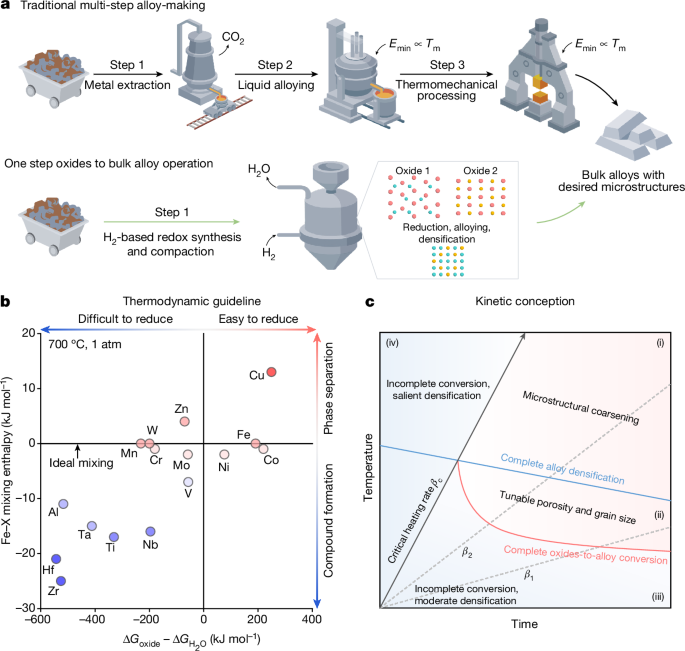Sustainable Bulk Alloy Production: Transforming Oxides into High-Performance Alloys through Innovative Solid-State Processing
Kernekoncepter
A novel H2-based redox synthesis and compaction approach that merges metal extraction, alloying, and thermomechanical processing into a single solid-state operation, enabling the production of sustainable bulk alloys with application-worthy properties.
Resumé
The traditional metallurgical production process involves three sequential steps: extracting metals from ores, mixing them into alloys through liquid processing, and then thermomechanical processing to achieve the desired microstructures. However, this approach is not sustainable, as it accounts for almost 10% of all greenhouse gas emissions due to the use of fossil reductants and high-temperature processing.
The authors present a new H2-based redox synthesis and compaction approach that reforms the traditional alloy-making process. This method merges metal extraction, alloying, and thermomechanical processing into a single solid-state operation, unlocking tremendous opportunities for sustainable bulk alloy design.
The authors provide a thermodynamically informed guideline and a general kinetic conception to dissolve the classical boundaries between extractive and physical metallurgy. They exemplify this approach using the case of Fe-Ni invar bulk alloys, which are known to be eco-unfriendly due to the high CO2 emissions associated with Ni production.
The authors' sustainable method turns oxides directly into green alloys in bulk forms, with application-worthy properties, all obtained at temperatures far below the bulk melting point, while maintaining a zero CO2 footprint.
One step from oxides to sustainable bulk alloys - Nature
Statistik
Almost 10% of all greenhouse gas emissions are due to the use of fossil reductants and high-temperature metallurgical processing.
Ni production causes more than 10 times higher CO2 emissions than Fe per kilogram.
Citater
"Here we present a H2-based redox synthesis and compaction approach that reforms traditional alloy-making by merging metal extraction, alloying and thermomechanical processing into one single solid-state operation."
"Our sustainable method turns oxides directly into green alloys in bulk forms, with application-worthy properties, all obtained at temperatures far below the bulk melting point, while maintaining a zero CO2 footprint."
Vigtigste indsigter udtrukket fra
by Shaolou Wei,... kl. www.nature.com 09-18-2024
https://www.nature.com/articles/s41586-024-07932-w
Dybere Forespørgsler
How can this solid-state processing approach be extended to other types of alloys beyond the Fe-Ni invar system?
The solid-state processing approach described in the context can be extended to other alloy systems by leveraging the fundamental principles of thermodynamics and kinetics that govern metal extraction and alloy formation. For instance, alloys such as aluminum-lithium (Al-Li) or titanium-aluminum (Ti-Al) could benefit from this method, as both systems require careful control of composition and microstructure to achieve desirable mechanical properties. By applying the H2-based redox synthesis, it is possible to directly convert metal oxides into these alloys, potentially reducing the energy input and CO2 emissions associated with traditional methods.
Moreover, the versatility of this approach allows for the exploration of a wider range of alloying elements, including rare earth metals and transition metals, which are often challenging to process sustainably. The key will be to develop specific thermodynamic models and kinetic pathways for each alloy system, ensuring that the solid-state reactions can occur efficiently at lower temperatures. This could lead to the creation of high-performance alloys with tailored properties for applications in aerospace, automotive, and electronics industries, all while maintaining a zero CO2 footprint.
What are the potential limitations or challenges in scaling up this sustainable alloy production method for industrial-scale manufacturing?
While the H2-based redox synthesis and compaction approach presents a promising alternative to traditional metallurgical processes, several limitations and challenges may arise when scaling up for industrial production. One significant challenge is the consistency and uniformity of the alloy properties across large batches. Achieving homogeneity in the microstructure and composition is critical for ensuring the performance of the final product, and this may be difficult to control in a large-scale setting.
Additionally, the availability and cost of hydrogen as a reductant could pose challenges. While hydrogen is abundant, its production, especially in a green manner (e.g., via electrolysis using renewable energy), may not yet be economically viable at scale. This could impact the overall sustainability and cost-effectiveness of the process.
Another potential limitation is the need for specialized equipment and processing conditions that may not be readily available in existing metallurgical facilities. Transitioning from traditional methods to this innovative approach may require significant investment in new technologies and training for personnel, which could slow down the adoption rate in the industry.
How might this innovative approach to alloy design and production contribute to the broader goals of a circular economy and sustainable materials management?
This innovative approach to alloy design and production aligns closely with the principles of a circular economy and sustainable materials management by minimizing waste and reducing the carbon footprint associated with metallurgical processes. By integrating metal extraction, alloying, and thermomechanical processing into a single solid-state operation, the method significantly reduces the energy consumption and greenhouse gas emissions typically associated with traditional alloy production.
Furthermore, the ability to directly convert metal oxides into usable alloys opens up opportunities for recycling and reusing materials. Scrap metal and industrial by-products can potentially be transformed back into high-quality alloys without the need for extensive processing, thus promoting resource efficiency and reducing the demand for virgin materials.
Additionally, this approach encourages the development of new, eco-friendly materials that can replace less sustainable options in various applications, contributing to the overall reduction of environmental impact. By fostering innovation in alloy design and production, this method supports the transition towards a more sustainable and circular economy, where materials are continuously reused and repurposed, ultimately leading to a more responsible management of resources.
0
